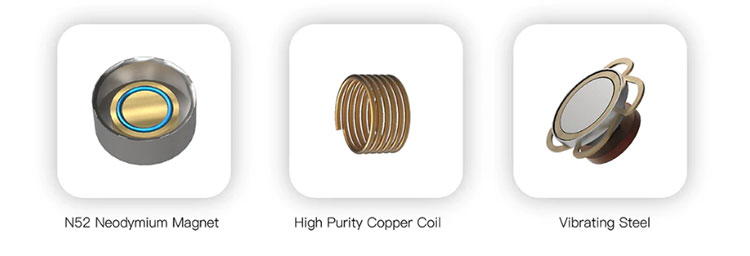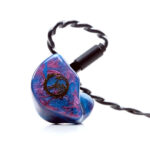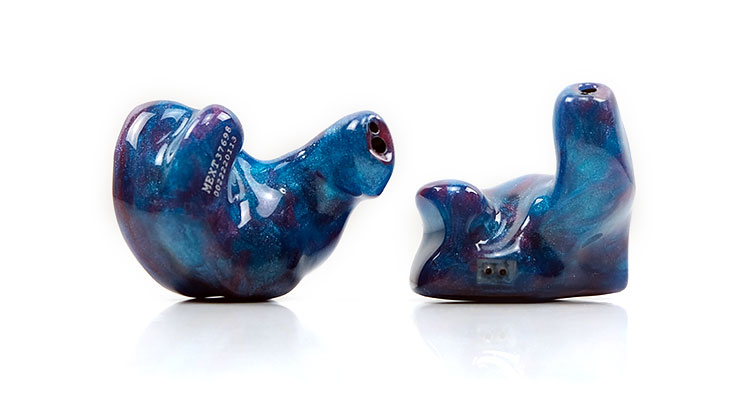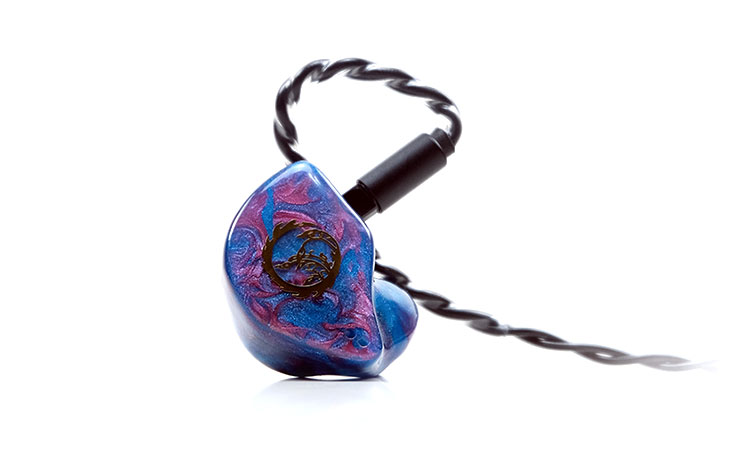We review the new Unique Melody MEXT which is a hybrid 6 driver custom IEM featuring Coil Bone Conduction technology. It is priced at $1399.
Disclaimer: This was sent to us as a sample for our honest opinion. Headfonics is an independent website with no affiliate links or services. We thank Unique Melody and MusicTeck for this opportunity.
To learn more about Unique Melody products previously covered on Headfonics you can click here.
Note, this feature follows our latest scoring guidelines which you can read up on here.
The MEXT is the 3rd in-ear monitor offering from Unique Melody to offer its unique bone conduction technology. Priced at $1399 SRP, (though the street price is now a little lower), it comes in a little cheaper than the current MEST series but its configuration is also changed to reflect that more competitive price point.
It comes in two formats, custom and universal with the custom version being the one featured in this review today. The price for the universal version is a little cheaper at $1200 and similar to the custom, you can already find some good deals lower than its SRP.
Just to point out custom pricing is the base price, some of the finishing or customization options available have additional fees ranging between $60 and $80 which, on the whole, is quite reasonable for custom IEM pricing these days.

Tech Inside
Configuration
The MEXT differs slightly from the MEST range by the exclusion of the use of electrostatic drivers. Instead, this is more of a traditional hybrid with the added bone conduction element.
That means a mix of dynamic and BA drivers with the precise configuration of a single 10mm dynamic driver for the lows and four balanced armature drivers with 2 for the mids and 2 for the highs using a 4-way crossover.
Original Bone Conduction
The unique element here is the OBC or “Original Bone Conduction” ‘driver’ which is an entirely new design from the previous ceramic vibrating plates inside the MEST series of monitors. This time around the OBC is a high-purity copper coil surrounded by a very strong N52 neodymium magnet and a vibrating steel sheet.
The positioning of the OBC is now to the rear of the shell so it can vibrate as close as possible to the ear bone and maximize the affection of the condition during playback. No stats have been released with regard to the frequency range covered by the new driver but there does seem to be an additional emphasis on the low-frequency response of the MEXT.
Rated efficiency is a little lower on paper compared to the MEST MKII with a specification of 16Ω and 108dB SPL as opposed to 12.3Ω and 112dB SPL. Quite possible the precise type of dynamic or balanced armature driver has changed from the MEST series. You can read more on our real-world testing on page 2 of this review on how it performed sensitivity-wise.
Design
Unique Melody has a wide range of both shell and plate options for the MEXT and nearly all of them are listed in a letter/number configuration. The review sample we have here is listed as Z18.
Now as I check on some sites that number is not listed but it comes fairly close to their official W16 purple maple faceplate. I suspect you can request it during the design process since that is exactly what I did myself based on a few pictures floating around their FB gallery.
It is a bold and beautiful design in my opinion and a striking visual compared to the lower-profile carbon fiber green patterns I am used to seeing on the MEST series. I also think they stand out a lot more than the plainer black from the universal format.
This is a fantasy-themed molten blend of purples and blues right throughout the plate and shell. I tend to prefer the shell and plate to match rather than two-toned or dual-designed plates and shells. The resin and polished finish between both the shell and body is excellent so you will be hard-pressed to find any gap or disruption in the design flow.
Other nuanced changes to the MEXT design include a dual venting port at the base of the front plate replacing the venting metal tube that was used inside the MEST MK II.
The MEXT has also retained the more commonly used flush 0.78mm 2-pin socket for both the custom and universal versions. That is something I deeply approve of since the previous JH Audio-styled screw locks and protruding stem sockets made it a difficult monitor for cable rolling. This version should present no issues if you want to do that.
Comfort & Isolation
The MEXT sample here is just slightly bigger than the MEST MKII custom possibly due to the need for a bit more space for the new coil-based POBC driver which needs to be at the very rear of the shell. The contouring is excellent but not quite as extreme either as our previous MEST MKII review unit.
The nozzle is also quite long, but that is just as I like it. Previously, UM made quite relaxed fittings, going back to the original Mason V3 in 2017. They seem to have ditched that with a nozzle length that goes much further.
In the case of this MEXT design, the fit is excellent with what deeper fitting. What that means is that the dual-bore nozzle is relatively long compared to some competing customs so it will go deeper and close to the second bend of your ear canal. That generally improves the security of the fit as well as the level of isolation.
Excellent also means not too much pressure on the ear canal to get what I would describe as a top-class level of isolation for a vented custom shell. This is almost BA levels of isolation with very little detectable background noise. That MEXT dual port is the only drawback for isolation levels that are required in hybrids for venting the dynamic driver.
The MEXT flush 0.78mm cable socket combined with the lighter shells also feels a little more relaxed in the ear than the bigger connecting stem arch and larger shells of the original MEST and older MASON series.
Stock Cable
For the MEXT, Unique Melody has retained the PW-partnered MEST copper M series cable but this time it’s the ‘UM Copper M1’ version as opposed to the M2 that came with the MEST MKII
Internally, this is a 26AWG gauge OFHC copper 4-wire geometry as opposed to a larger 24AWG OFC copper inside the M2. It is wrapped in a carbon fiber sleeve and applied with a shinier and slightly stiffer black PVC coating on the external surface compared to the M2.
The wire is braided up to a black metal long barrel splitter and then twisted up to the left and right matching black 2-pin barrels. The jack options come in TRS 3.5mm as well as TRSS 2.5mm and pentaconn 4.4mm depending on your preferences.
I do love the new barrel on these M cables. It perfectly matches the splitter and connector barrels with its matte black finish and minimalist branding in white. It also has a slightly concaved shape to allow your pinkies to better grip the barrel.
The only caveat is the barrel size which is a bit on the fat size so just be aware of that if you are using sources with very little space between output ports. The other noticeable finishing is a soft memory silicone wrap which seems to be the norm now on good aftermarket cables. It is soft, springy, and easy on the back of your ear.
In terms of handling, the overall feel is slightly harder than some PVC cables I have used before but otherwise, it does not have much of a memory-retentive quality to its design. It is not that heavy either with super low microphonics below the splitter and a nice balance with no pressure hotspots around the ears.
Packaging & Accessories
The MEXT comes in almost the exact same packaging and accessory lineup as the MEST II. That means a compact all-black jewelry slider-type retail box with gold embossed branding on the front.
Inside, you have a dual tray with the carry case at the top and the rest of the accessories in the lower slide-out. Inside the carry case, you will find the UM M1 cable and the drivers whereas the lower tray will hold everything else including the tips and changeable metal filters if you bought the universal version.
The carry case is the same Dignis-designed blue zippered leather case from the MEST MKII with internal fabric dividers to protect the drivers from the cable barrels. It is a bit big for pockets but will allow you to stuff a few cables in there alongside the drivers without being cramped for space. It is also stiffened on the outside for a degree of protection when in use.
Accessories for the MEXT custom version also include a cleaning cloth, warranty card, and your IEM organizer strap.
One small change from the MEST MKII accessory lineup is the type of IEM organizer strap with this one being a somewhat cheaper black and white stitched leather button strap rather than the cool MEC (magnetic earphone clip) suede-finished cable organizer strap which doubles up as a shirt clip. Well, the MEXT is a cheaper model after all so not that surprised.
Sound Impressions
Summary
In a nutshell, the MEXT sounds like the darker more malevolent cousin of the MEST monitor series. This is a custom IEM that doubles down on the bass presence, smoothes out the mids, and relaxes the treble to produce a tuning that is forgiving but weighty and denser sounding at the same time.
There is less of a U and more of an L on the low end with the sub-bass dominating but also staying north of neutral to the lower mids. Lower pitching instruments and some chest vocal mixes are to the fore but so also the upper mids that balance out the low-end a little and prevent everything from sounding dark or recessed.
The shimmer of the electrostatic drivers from the MEST series is absent with a more distinct BA delivery and slightly less of that pristine airy quality that was very much present on the MEST V1.
Notes are richer, the bass fundamental stronger and the timbre just that little bit warmer in the process. Vocals are broad, smooth, and free of unnatural sibilance. If there is any critique it might be the comparative lack of air and resolution compared to the MEST series in the highs but understandable given it lacks that quad electrostatic driver array.
This is a monitor that pairs exceedingly well with clean and dynamically powerful sources. It can take the power but is also sensitive enough to pair well with lower output voltage units such as dongles. The key difference for me was in the superior level of clarity and separation from more powerful sources such as the FiiO M17.
Frequency Response
The MEXT FR is not massively different in shape to the MEST MKII rather the amplitude is a bit higher throughout to around 2-3k at its lowest point. This is a relatively L-shaped or wedge-type curve with the highest point at around 20Hz to 50Hz then a slow linear-type drop to the mids staying north of neutral throughout.
That means you get a fair bit of sub-bass dominance on the low-end with a slight reduction in punchiness over rumble and a degree of warmth and presence coming into the lower mids also.
Like the MEST MKII, the MEXT mids from 1-3k are relatively relaxed but due to its faded upper treble tuning from 7-10k and the lack of electrostatic drivers it has less of a sheen or treble shimmer influence. You get a bit less clarity and pop from the resulting MEXT midrange notes and a more rounded liquid tone.
There is some gain from 4-6 or 7k max but it’s slightly behind the peak sub-bass amplitude but enough to balance it out. Countertenor or soprano head vocals will image further forward and come through quite clearly as well as some percussion passages. It is still not what I would call a sharp or bright mix, however.
Beyond that and as mentioned, the MEXT does not have the same treble reach as the e-stat-infused MEST series so there is a little less headroom and air here. It does not sound like you are hitting a brick wall, but rather the energy is more on the relaxed side comparatively speaking.
Timbre
The MEXT timbre is warm and smooth with a liquid attack that breaks into a broad richly textured sustain and in the case of the low-end, a natural level of decay.
Notes at the very low end sound powerful, with a strong fundamental that gets tighter in terms of layering and definition the more power you throw at it. Cleaner sources do better in terms of bass character and clarity with the MEXT.
Lower pitching instruments such as bass guitar slaps and plucks are full-bodied, even harmonic dominant, and image a bit further forward sounding powerful and physical in their performance. Male chest vocals have a degree of physicality and presence within the MEXT performance with a touch of euphony as well.
Forward upper mids bring higher pitching vocals to the fore yet still retain that same smooth theme that runs throughout the MEXT tuning. Natural sibilance is still there but it is not over-emphasized with more of an even harmonic bias than any sharp partial overtones.
Those looking for a raspy energetic percussion coloration from the MEXT might be disappointed. Personally, I feel they are quite natural on the hit and strike but do not possess the same clean energy and presence as the MEST series percussion performances.
Staging
The MEXT is engineered to impress from the bottom up and that means plenty of power. Not EVO levels of power but substantive and much more physical sounding compared to the MEST series. I almost feel like we can expect to see this new OBC driver in any MKII of the MEST given how well it performs.
Instruments on the MEXT that pitch from 20Hz up to about 1k are north of neutral and to the fore in terms of imaging and presence. Rhythmic instruments are weighty and convincing in terms of authority.
I just love how bass guitars sound so planted and firm in the mix with the MEXT tuning, a particular appeal of mine when playing thrash or heavy rock that’s not so dry in the mix such as HellYeah or Metallica’s Black Album.
Vocals and percussion on the upper mids rise also have a good presence and do image fairly forward creating a slightly intimate feel to their delivery. That is enhanced by the faded upper treble that reduces the sense of space and air above and around, at least perceptibly so.
Still, the sense of depth created by the MEXT dynamic driver will deliver some ‘macro grandeur’ in the staging quality of the MEXT. It is not quite as razor-sharp as the MEXT in its imaging but then I would not expect it to be so. Reasonably accurate but also enjoyably immersive and believable would be my watchwords here.






